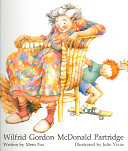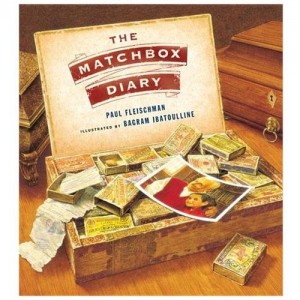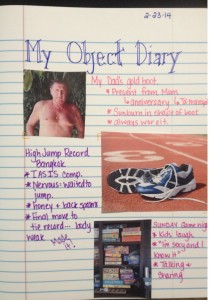I am constantly searching on Amazon and other book sites for new books and suggestions from other people. Many times I’m searching for upper grade picture books with historical references. I think it’s so important that even older elementary and middle school students are exposed to beautifully written and illustrated picture books. This book came up as a suggestion as a book that I might be interested in. I wasn’t completely sold on the idea until I read the review on Amazon.com. Sold, I bought it!
Why I finished it
This is a beautiful story about an American immigrant from Italy who is sharing the story of his life with his granddaughter. Since the man was unable to write, he kept mementos of his life in little matchboxes. The granddaughter found the cigar box that contained all the matchboxes, and one by one she asks what each object means. The grandfather holds each object and begins to share the memories that each object holds. The stories have historical context, but also illustrate the importance of sharing stories and passing down family history. While learning snippets of what it was like for immigrants, the reader is pulled in to a beautiful relationship between a small child and her grandfather. You almost feel as if you are sitting in the old library with them listening to the detailed memories.
Who I would give it to
This is a great picture book to help teach how objects tell stories and the importance of keeping a diary. It is also really good for teaching how life was different and how difficult life was for American immigrants. It is a great book for kids who enjoy historical fiction.
Integration
Writers’ Notebook
With grades 3-4 I’ve always read Wilfrid Gordon McDonald Partidge by Mem Fox to the students in the first week of school. It is  the story of a little boy who lives next door to an old age home. He really likes one of the residents, because she has four names just like him. One day he overhears his parents say that she has lost memory. Unsure of what a memory is, he asks as many of the residents as possible what a memory is. He gets all kinds of answers from “something warm,” to “something funny,” to “something that makes you cry,” etc. So in an effort to help his favorite person get her memory back he finds objects that represent each definition of what a memory is. As he gives her the items, she slowly remembers different memories from her past and shares them with Wilfrid. After reading this to my students they are asked to bring in their own memory bags that follow the definitions of what a memory is from the the book. Once the students have shared their memories with a small group, they write down the ideas in their notebook.
the story of a little boy who lives next door to an old age home. He really likes one of the residents, because she has four names just like him. One day he overhears his parents say that she has lost memory. Unsure of what a memory is, he asks as many of the residents as possible what a memory is. He gets all kinds of answers from “something warm,” to “something funny,” to “something that makes you cry,” etc. So in an effort to help his favorite person get her memory back he finds objects that represent each definition of what a memory is. As he gives her the items, she slowly remembers different memories from her past and shares them with Wilfrid. After reading this to my students they are asked to bring in their own memory bags that follow the definitions of what a memory is from the the book. Once the students have shared their memories with a small group, they write down the ideas in their notebook.
With this new book, The Matchbox Diary, I like the idea of using a similar activity, but for middle grades. After reading the book, students can bring in objects that hold a memory of their life. I usually have students bring in 3 to 4 items. It is crucial that students are given time to discuss their memories with classmates first. Writing should be a social process. By sharing their story orally, they are essentially pre-writing. Once they have shared their stories, the students can create a notebook entry. They can draw or paste in their objects and jot down major points of their story. Now they have 3 to 4 seed ideas ready to be drafted!








Leave a Reply